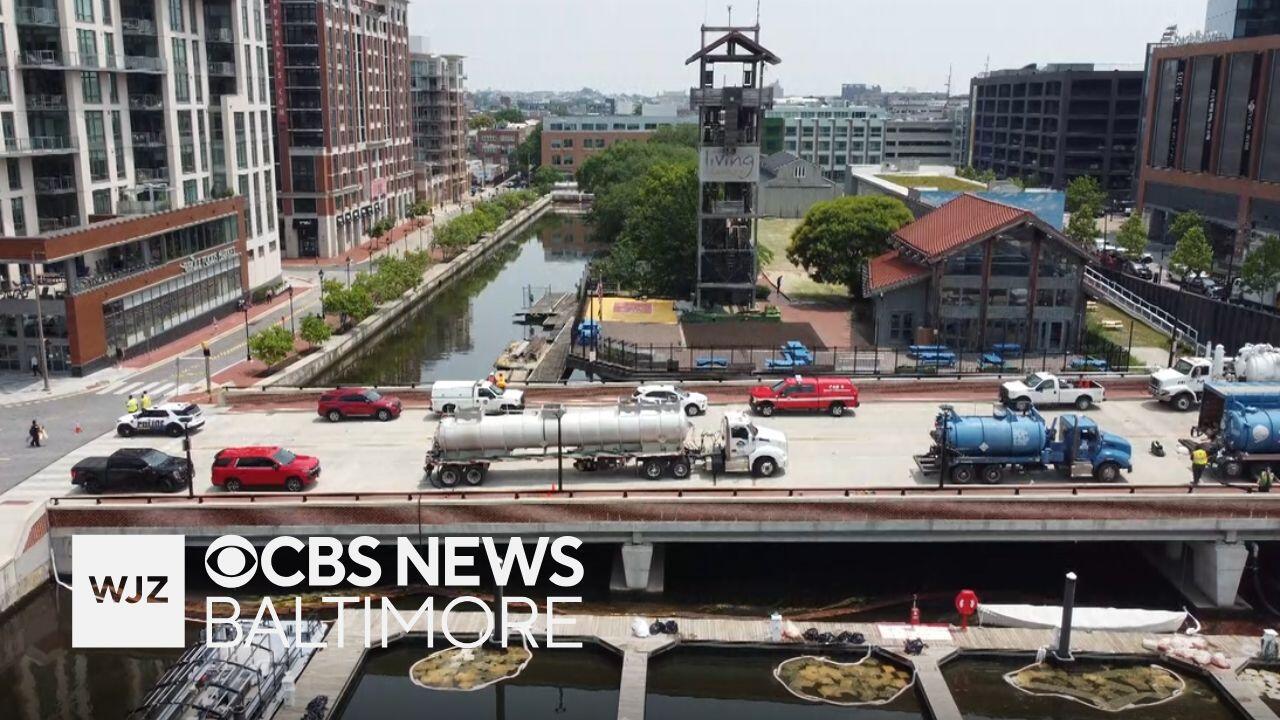Here's how 2,000 gallons of diesel fuel from Johns Hopkins Hospital spilled into Baltimore's Inner Harbor.
Thousands of gallons of diesel fuel spilled into Baltimore's Inner Harbor Wednesday, dyeing the water red and prompting concerns about long-term environmental impacts.
The spill began more than a mile away on a Johns Hopkins Hospital campus on Fayette Street.
Fuel spill originates from Johns Hopkins Hospital
The 2,000-gallon fuel spill occurred when tanks for Johns Hopkins' emergency generators were overfilled.
The diesel went into the stormwater system and drained into the Patapsco River.
"Unfortunately, this is something we deal with because of our underground pipe infrastructure that basically treats our streets as our streams," said Alice Volpitta, from the non-profit Blue Water Baltimore. "And by that, I mean anything that spills on our streets goes right into our streams without being treated."
Blue Water Baltimore's boat was already scheduled to do routine water quality monitoring on the day of the spill.
"We were able to leverage that opportunity to take our boat out and try to see if there's any impact from this fuel spill," Volpitta said.
Volpitta said it is crucial to get to the bottom of what happened.
"Was there something that went wrong mechanically or potentially as a result of user error in the refueling process? That's something we don't know yet, but if there aren't already, there ought to be stricter regulations in place to make sure spills like this don't happen," Volpitta said. "We just don't know exactly where it went wrong."
Volpitta added, "The regulatory agencies need to get a handle on the full extent of the spill, but also what happened at Johns Hopkins Hospital to allow this spill to occur."
Johns Hopkins said in a statement it is "fully committed to funding the cleanup and remediation efforts in the Inner Harbor, including any impacts to local wildlife."
A Johns Hopkins spokesperson added that it is reviewing how the tanks spilled fuel into the harbor.
Previous Baltimore-area fuel spills
While 2,000 gallons is larger than many recent spills, it happens more often than some may realize.
In 2024, 500 gallons of fuel spilled after a boat fire in Canton.
In 2023, Harbor East waters were again dyed red .
In 2017, a truck carrying diesel overturned on the JFX, spilling fuel into the Jones Falls, which headed to the harbor.
Environmental concerns of Baltimore fuel spill
A fuel spill in Baltimore's harbor can bring about many environmental concerns, including for wildlife.
"Diesel is lighter than crude oil and evaporates more quickly, but I think it can seep into mud or marshy areas, and some of it may sink below the surface, so it's very important to remediate it as soon as possible," said Dr. Sam Sherchan, a biologist at Morgan State University.
Sherchan noted that the quick use of pumps and absorbent material is crucial.
"They act like paper towels where they soak up the diesel, and the skimmers they're using are mechanical devices that skim the diesel off the water," Dr. Sherchan said.
Sherchan has concerns about the long-term environmental impact. The state Department of Natural Resources has already worked to clean wildlife.
"The contaminated mud, when it gets stirred up again it can become toxic to wildlife," Sherchan said. "Animals that come into contact with the water may become sick and die. In the long term, we want to see continuous monitoring of water and air to make sure that it's safe."
Baltimore's Harbor Splash
in late May, athlete Katie Pumphrey swam in the Inner Harbor.
The next public Harbor Splash event is scheduled for 15 days after the fuel spill.
It aims to showcase progress in cleaning up waterways .
"These types of episodic pollution incidents are just part of the unique set of challenges facing urban waterways," Volpitta said.







